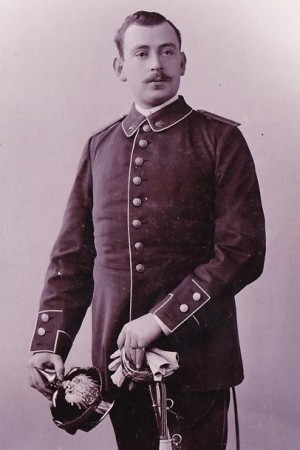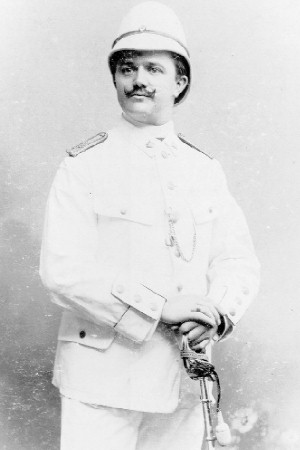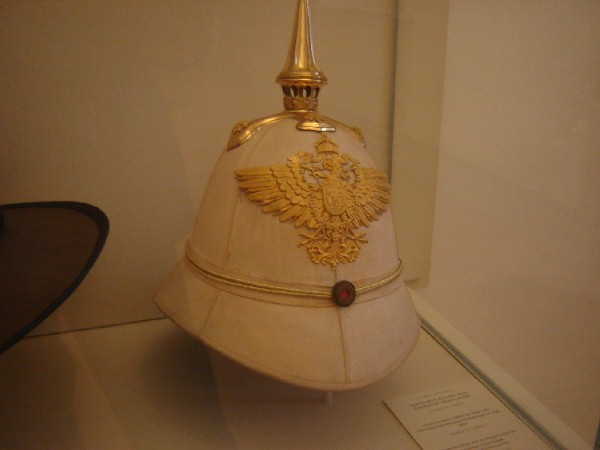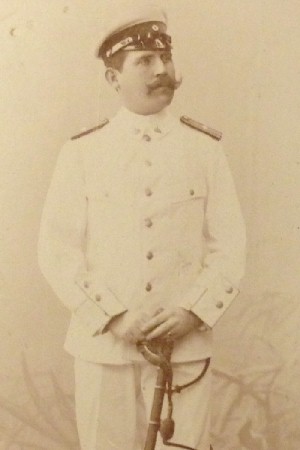Uniforms of German Officers and
NCOs of the Schutztruppe in East Africa 1891-96
The Schutztruppe for German East Africa
was formed by an Imperial order on 22nd March 1891 from the existing units of the Wissmanntruppe. On 4th June 1891 new uniforms were authorised for
the German officers and NCOs of the East African Schutztruppe to replace their
old Wissmanntruppe
Uniforms. When the Schutztruppe
for Cameroon were formed on 9th June 1895 they also followed
the same uniform regulations. The new uniforms were not all issued
overnight and the Wissmanntruppe uniforms were probably still worn
for some time afterwards. Similarly although
the 1891 uniforms were officially replaced in 1896, period
photographs still show them in use for some years afterwards.
The 1891 uniforms were principally distinguished by having
three-buttoned Brandenburg style cuffs and yellow metal imperial
crown badges on the corners of the collar. The uniform came in three
different styles- a dark blue home uniform piped in white, a white
tropical uniform piped in blue and a khaki field uniform piped in
yellow. Interestingly the uniforms were originally designed to have
Hungarian style cuffs (as worn by the Hussars of the Imperial army) but the these were changed to
Brandenburg cuffs before being receiving the Kaiser's final
authorisation.
Dark Blue Home Uniform
The dark blue home
uniform was based on the Prussian 1842 infantry tunic with several
distinctions. It had a stand and fall collar with yellow metal brass
Imperial crowns in
each collar corner. The cuffs were Brandenburg style with three
buttons placed vertically. Curiously, several period photographs
show the blue tunic worn with the lowest buttoned undone. Other
photographs show the cuffs fully buttoned. The tunic had no visible
pockets and was fastened with eight buttons down the front. Officers
wore shoulder straps displaying their rank (see
Officers Rank Insignia Page),
held at the top with a small button. NCOs had no shoulder straps,
but displayed their rank with large yellow metallic chevrons on the upper left arm. All buttons were of yellow metal with the imperial
crown. The collar, cuffs, front and rear belt and skirts were all
piped in white.
The regulations of 1891 stated that a
white shirt collar was to be worn with the tunic (in its blue, white
and khaki variations) and that it be visible over the tunic collar,
period photographs show that it was not always worn this way.
A black cravat ("Halstuch") was also authorised under the
collar.
The trousers for the dark blue uniform
were matching dark blue with white piping and officers having a strap going under
the foot.
White Tropical Uniform
The tropical uniform for garrison duty was of white wool with
Brandenburg cuffs and a
stand and fall collar. It had a yellow metal imperial crown badge at
each corner of the collar. It had four unpleated
buttoned pockets and six buttons down the front, although some white
tunics have been seen in period photographs with only five buttons. Officers wore
shoulder straps displaying their rank (see
Officers Rank Insignia Page),
held at the top with a small button. NCOs had no shoulder straps. The rear of the tunic had a buttoned belt to
adjust the width. All buttons were of yellow metal with the imperial
crown. The collar, cuffs, front and rear belt and skirts
were all piped in blue. The trousers for the white uniform
were matching white, without piping.
Khaki Tropical Uniform
The tropical uniform for field duty was of khaki drill. The
shade of khaki varied considerably with some period photographs and
illustrations showing it to be a much darker brown than later used
by the Schutztruppe. The cut and details of the uniform were the
same as for the white uniform except with yellow piping. The trousers for the khaki uniform
were matching khaki, without piping.
Rank Insignia
Officers rank insignia was
worn in the form of shoulder straps in white metallic lace with
threads of red and black. The straps had yellow metal pips to denote
the different ranks. The Kommandeur and Oberführer wore senior
officer braided straps, the Kommandeur had a single pip, the Oberführer did
not. The Kompagnieführer wore the insignia of a Hauptmann, the
eleven old lieutenants wore the insignia of a Premierlieutenant and
the newer lieutenants wore the insignia of a Sekondlieutenant (see
Officers Rank Insignia Page).
NCOs had no shoulder straps and their rank
insignia was shown as
yellow metallic chevrons on the upper left arm. The Feldwebel wore
three chevrons, the Sergeant two and the Unteroffizier one. The
uniform regulations do not specify the exact shape of the chevrons
except to say that they were worn point down. Two distinctly
different shaped chevrons have been seen in use in period
photographs, one being with
large slightly rounded chevrons with vertical edges and other being
smaller chevrons with horizontal edges similar to those worn after
1896. The different shaped chevrons have been seen within small
groups of NCOs of the same unit in period photographs.
I have so far seen no examples of
specialist insignia (such as musicians swallows nests, marksmanship
lanyards and other badges) worn with these uniforms in period
photographs and none are mentioned in the uniform regulations of
1891. The insignia and uniform variations worn by non-combatant
officials such as doctors, paymasters and gunsmiths are described
below.
Headdress
Pickelhaube
On home duty in Germany, Schutztruppe officers and NCOs were authorised to
wear a black leather Prussian infantry spiked helmet ("Pickelhaube")
with several distinctions. The Schutztruppe Pickelhaube had a squared peak
and an imperial eagle with spread
wings in yellow metal across the front. The fittings and spike were
also in yellow metal. Officers spikes were fluted and had a
cruciform base pinned with a star in each corner. NCOs spikes were
smooth with a base held by four plain buttons. An imperial cockade was worn under the right
side chinstrap boss. No cockade was worn on the left side. The
chinscales were also in yellow metal.
Recommended External Link - Traditionsverband Forum discussion on
Schutztruppe Pickelhauben
Tropical Helmet
The newly authorized tropical helmet was of a
similar shape to that of the Wissmanntruppe- tall and made of
cork or pith covered in white cloth. It had the same yellow metal
imperial eagle and spike as the Pickelhaube. Below the eagle at the
front was a small imperial cockade.
For officers
a band of gold lace ran around the hatband.
On garrison duty the eagle, spike and officers lace were removed.
The spike was then replaced by a round white ventilation cap.
On
field duty the same details were removed and a khaki cover worn over
the helmet held in place by the white ventilation cap which was
screwed on after the cover had been put on. The imperial cockade was
also worn on the outside of the cover.
It seems from surviving examples
that khaki helmets were also to made the same specifications although not
authorised.
Field Cap
The field cap was white with a dark blue hatband and no piping.
It had a small imperial cockade at the front and a black leather
peak and chinstrap. The chinstrap was held on both sides with a
small yellow metal button bearing the imperial crown. Two different
types of this cap were authorized, one of white linen for use in the
colonies and the other of white cloth or duffel-wool for use on home
duty in Germany.
Other Uniform Items
Greatcoat
For home use greatcoats were the same as for the Marine Infantry but
had the Schutztruppe's yellow metal buttons with an imperial crowns.
Thus officers wore a grey double breasted "Paletot" with a
dark blue collar and white facing, while NCOs wore a dark grey/black
single breasted "Mantel" without the Marine Infantry insignia. I
have yet to see a period photograph of either greatcoat being worn.
Officers Frock Coat
A knee length double breasted frock coat
("Überrock") was authorised for officers to wear on
home duty. It was dark blue in the style of the Marine Infantry but
with the Schutztruppe's yellow metal buttons each with the imperial
crown It had six down each
side and two on either side of the straight rear skirts. The high
collar and the piping around the cuffs and rear skirts was white.
Officers displayed their rank insignia on their shoulder straps in
the usual manner (see
Officers Rank Insignia Page). I
have yet to see a period photograph of the frock coat being worn.
|

Sekondlieutenant
East
African Schutztruppe c1891-96
He wears the dark blue home
uniform with Pickelhaube. Note the Brandenburg cuffs with
only two buttons closed and the Imperial crown badges on the
collar.
Photo © Sergio Semino
of
Militaria-Online

Doctor Hugo Lichtenberg
East African Schutztruppe c1891-96
He wears the 1891 white tropical uniform (note the
crowns on the collar and Brandenburg style cuffs). He wears
an 1891 tropical helmet with cockade and yellow metallic
lace around the hatband.
Photo ©
Frankfurt University Koloniales Bildarchiv

Officers 1891 Tropical Helmet
with the cruciform base spike and Imperial eagle as worn
on parade duty. Note also the officers metallic lace strip
around the hatband.
(See
Tropical Helmets Details Page)
Photo
© C Dale
from the Wehrgeschichtliches Museum,
Rastatt

Premierlieutenant
East
African Schutztruppe c1891-96
He wears the 1891 white tropical uniform (note the
crowns on the collar and Brandenburg style cuffs with only
two buttons fastened). His rank can be seen as a single pip
on each shoulder strap. He has the white peaked cap with
hatband in blue.
Photo ©
T.S. Allen |